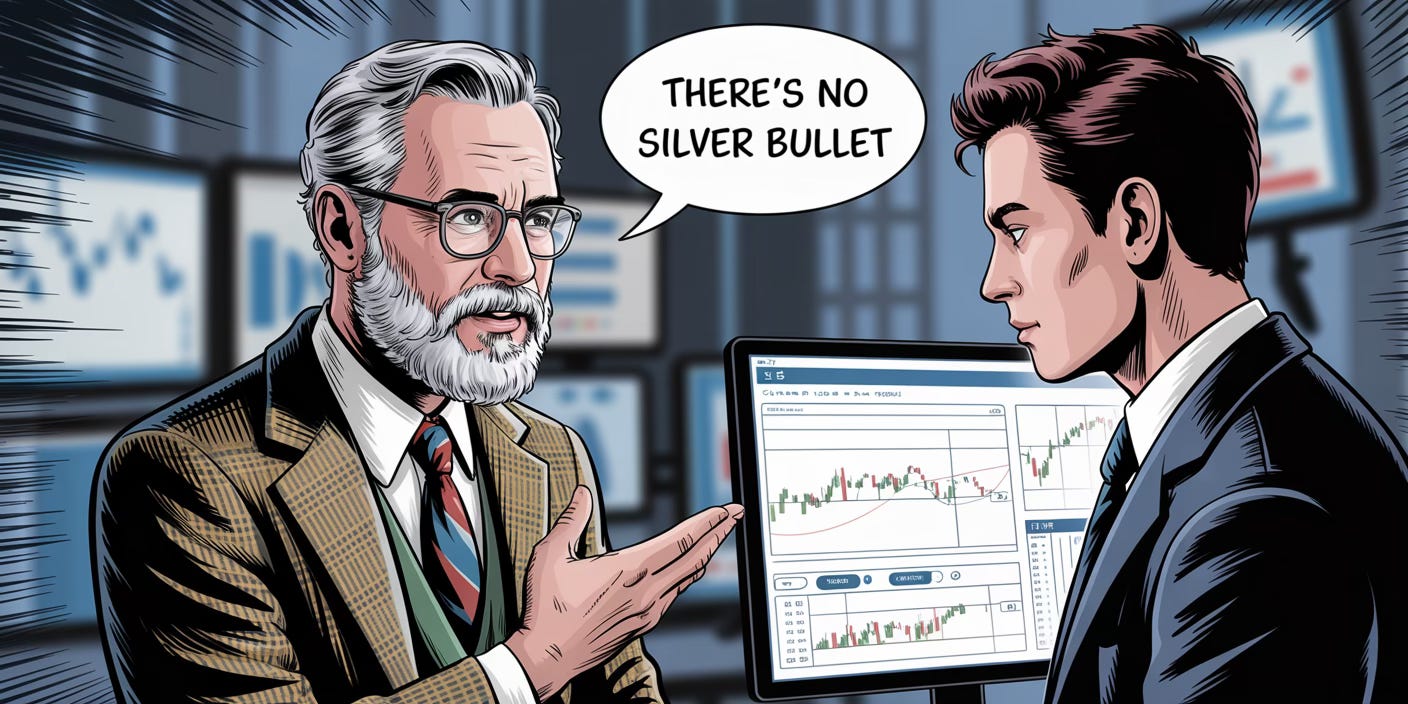Why Do New Traders Think There's a 100% Win Rate System?
Every experienced trader remembers their first six months. Not because they were profitable (most weren’t) but because of the belief that somewhere out there existed the perfect trading system. The magical formula. The silver bullet that would eliminate losses forever.
They now know it was a waste of time and money. Yet they also know something else: telling a new trader this truth is about as effective as telling a teenager not to drive fast. The warning goes in one ear and out the other, not because they’re stupid, but because some lessons can only be learned through experience.
The Inevitable Search
Walk into any trading forum, Discord server, or chat room, and you’ll find new traders asking about the “best” indicator combination, the “most accurate” strategy, the setup with the “highest win rate.” They’re not asking because they want to understand markets—they’re asking because they believe certainty exists, and they just haven’t found it yet.
This belief is perfectly rational from their perspective. After all, trading is presented as a skill, and skills have mastery levels. A master chef doesn’t burn food. A master carpenter doesn’t make crooked cuts. So why would a master trader take losses?
Why Telling Them Doesn’t Work
Experienced traders see this and try to help. They explain that trading is about probabilities, not certainties. That losses are not failures but the cost of doing business. That edge comes from consistency and risk management, not from winning every trade.
The new trader nods along. They might even say they understand. But they don’t, not really. Because understanding something intellectually and understanding it viscerally are two entirely different things.
Here’s where it gets even more bizarre: when you tell a new trader that the silver bullet doesn’t exist, they don’t think you’re speaking from experience. They think the opposite. They think that you simply haven’t found it yet. In their mind, you’re not a wise veteran warning them away from a dead end; you’re someone who gave up too early, who wasn’t smart enough or persistent enough to discover the secret.
“Maybe it doesn’t exist for you,” they think. “But I’m different. I’m more dedicated. I’m more analytical. I’ll figure out what you couldn’t.”
This cognitive distortion is perfectly rational from their perspective. After all, if you had found the holy grail, why would you tell them about it? And if you’re still taking losses after years of trading, doesn’t that just prove you’re not as good as you could be?
Eventually Reality Kicks In
Every trading strategy loses sometimes. Every edge is probabilistic. Certainty is a mirage.
This painful realization is where real trading education begins. Once a trader accepts that losses are inevitable, they can start asking better questions:
Not “How do I never lose?” but “How do I lose small?”
Not “What’s the perfect entry?” but “How do I manage this position?”
Not “Which strategy wins most?” but “Which approach fits my psychology?”
They stop chasing indicators and start studying market structure. They stop obsessing over win rate and start focusing on risk-reward. They stop looking for certainty and start building systems that work despite uncertainty.
The transformation is profound. The trader who six months ago was desperately seeking a 100% win rate strategy now understands that a 40% win rate can be incredibly profitable with proper risk management. The one who feared losses now sees them as feedback.
The Role of Time
Could this learning process be accelerated? Could new traders somehow skip the holy grail phase and jump straight to mature trading?
Probably not, at least not for most people. The search itself serves a purpose. By testing dozens of strategies, new traders learn what doesn’t work. By chasing certainty, they discover the limits of prediction. By experiencing failure repeatedly, they build the emotional resilience needed for long-term trading.
It’s like asking if teenagers could skip the phase where they think they’re immortal. That phase, annoying as it is to parents, seems to be a necessary part of development.
The Wisdom of Scars
In the end, every trader’s journey includes a graveyard of failed strategies, blown accounts, and abandoned “perfect systems.” This is the price of education in a field where experience is the only real teacher.
The trader who spent six months searching for the holy grail and came up empty didn’t waste that time. They learned what they needed to learn in the only way they could learn it. They paid their tuition to the market, and in return, they received something far more valuable than a perfect system: they received perspective.
So to the new trader reading this, desperately seeking that formula that will change everything: you probably won’t believe what I’m about to say, but I’ll say it anyway. The holy grail doesn’t exist. You’re going to search for it regardless. You’re going to lose money in the process. And that’s okay.



